Abstract
Human gait is the manner of walking in people. It is influenced by weight, age, health condition or the interaction with the surrounding environment. In this work, we study gait changes under cognitive load in healthy males and females, using machine learning methods. A deep learning model with multi-processing pipelining and back propagation techniques, is proposed for cognitive load gait analysis. The IMAGiMAT floor system enabling sensor fusion from plastic optical fiber (POF) elements, is utilized to record gait raw data on spatiotemporal ground reaction force (GRF). A deep parallel Convolutional Neural Network (CNN) is engineered for POF sensors fusion, and gait GRF classification. The Layer-Wise Relevance Propagation (LRP), is applied to reveal which gait events are relevant towards informing the parallel CNN prediction. The CNN differentiates between males and females with 95% weighted average precision, and cognitive load gait classification with 93% weighted average precision. These findings present a new hypothesis, whereas larger dataset holds promise for human activity analysis.
Access this chapter
Tax calculation will be finalised at checkout
Purchases are for personal use only
References
Yogev, G., Hausdorff, J.M., Giladi, N.: The role of executive function and attention in gait. Official J. Mov. Disord. Soc. 23(3), 329–342 (2008)
Woollacott, M., Shumway-Cook, A.: Attention and the control of posture and gait: a review of an emerging area of research. Gait Posture 16(1), 1–14 (2002)
Bertram, J.E.A., Ruina, A.: Multiple walking speed–frequency relations are predicted by constrained optimization. J. Theor. Biol. 209(4), 445–453 (2001)
Holt, K.G., Jeng, S.F., Ratcliffe, R., Hamill, J.: Energetic cost and stability during human walking at the preferred stride frequency. J. Motor Behav. 27(2), 164–178 (1995)
Selinger, J.C., O’Connor, S.M., Wong, J.D., Donelan, J.M.: Humans can continuously optimize energetic cost during walking. Curr. Biol. 25(18), 2452–2456 (2015)
Adenzato, M., Brambilla, M., Manenti, R., et al.: Gender differences in cognitive theory of mind revealed by transcranial direct current stimulation on medial prefrontal cortex. Sci. Rep. 7(41219) (2017). https://doi.org/10.1038/srep41219
Sherwin, B.B.: Estrogen and cognitive functioning in women. Endocr. Rev. 24(2), 133–151 (2003)
Zaidi, Z.F.: Gender differences in human brain: a review. Open Anat. J. 2, 37–55 (2010)
Bruening, D.A., Frimenko, R.E., Goodyear, C.D., Bowden, D.R., Fullenkamp, A.M.: Sex differences in whole body gait kinematics at preferred speeds. Gait Posture 41(2), 540–545 (2015)
Laws, K.R., Irvine, K., Gale, T.M.: Sex differences in cognitive impairment in alzheimer’s disease. World J. Psychiatry 22(1), 54–65 (2016)
McPherson, S., Back, C., Buckwalter, J.G., Cummings, J.L.: Gender-related cognitive deficits in alzheimer’s disease. Int. Psychogeriatr. 11(2), 117–122 (1999)
Alharthi, A.S., Yunas, S.U., Ozanyan, K.B.: Deep learning for monitoring of human gait: a review. IEEE Sens. J. (2019). https://doi.org/10.1109/JSEN.2019.2928777
Cantoral-Ceballos, J., et al.: Intelligent carpet system, based on photonic guided-path tomography, for gait and balance monitoring in home environments. IEEE Sens. J. 15(1), 279–289 (2015)
Suutala, J., Fujinami, K., Röning, J.: Gaussian process person identifier based on simple floor sensors. In: Roggen, D., Lombriser, C., Tröster, G., Kortuem, G., Havinga, P. (eds.) EuroSSC 2008. LNCS, vol. 5279, pp. 55–68. Springer, Heidelberg (2008). https://doi.org/10.1007/978-3-540-88793-5_5
Yun, J., Woo, W., Ryu, J.: User identification using user’s walking pattern over the ubiFloorII. In: Hao, Y., et al. (eds.) CIS 2005. LNCS (LNAI), vol. 3801, pp. 949–956. Springer, Heidelberg (2005). https://doi.org/10.1007/11596448_141
Montavon, G., Lapuschkin, S., Binder, A., Samek, W., Müller, K.R.: Explaining nonlinear classification decisions with deep taylor decomposition. Pattern Recogn. 65, 211–222 (2017)
Bharadhwaj, H.: Layer-wise relevance propagation for explainable deep learning based speech recognition. In: 2018 IEEE International Symposium on Signal Processing and Information Technology (ISSPIT), pp. 168–174 (2018)
Maximilian, A., et al.: iNNvestigate neural networks (2018). https://github.com/albermax/innvestigate
Isaac, E.R.H.P., Elias, S., Rajagopalan, S., Easwarakumar, K.S.: Multiview gait-based gender classification through pose-based voting. Pattern Recogn. Lett. 126, 41–50 (2018)
Author information
Authors and Affiliations
Corresponding author
Editor information
Editors and Affiliations
Rights and permissions
Copyright information
© 2019 Springer Nature Switzerland AG
About this paper
Cite this paper
Alharthi, A.S., Ozanyan, K.B. (2019). Deep Learning and Sensor Fusion Methods for Studying Gait Changes Under Cognitive Load in Males and Females. In: Yin, H., Camacho, D., Tino, P., Tallón-Ballesteros, A., Menezes, R., Allmendinger, R. (eds) Intelligent Data Engineering and Automated Learning – IDEAL 2019. IDEAL 2019. Lecture Notes in Computer Science(), vol 11871. Springer, Cham. https://doi.org/10.1007/978-3-030-33607-3_25
Download citation
DOI: https://doi.org/10.1007/978-3-030-33607-3_25
Published:
Publisher Name: Springer, Cham
Print ISBN: 978-3-030-33606-6
Online ISBN: 978-3-030-33607-3
eBook Packages: Computer ScienceComputer Science (R0)

